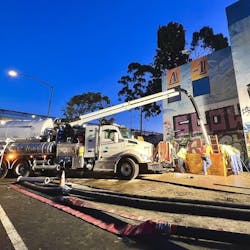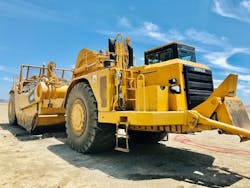Steps Toward a Sustainable Fleet
Nearly half of construction and engineering managers surveyed in 2021 by SAP and Oxford Economics said sustainability is a major concern for their company. Respondents also said, however, that their companies were more likely to set sustainability goals rather than have taken concrete steps to achieve those goals.
As construction equipment-using organizations move toward sustainability, fleet managers must respond. But first, they must understand what’s being asked of them.
Click here for a list of sustainability resources. Email [email protected] with additional sources.
The challenge is how to bring every stakeholder’s expectation of what sustainability is under the same umbrella. How sustainability is defined is subjective and depends on goals set at each management level. Owners and C-suite managers view sustainability as growing new business and investing for long-term growth. Engineers and project managers look at renewable materials and greener installations. When management hands down its sustainable mission statement, equipment managers understand that working sustainably affects almost every line item they touch. Need a little guidance? Yes, please.
“Sustainability is simply a series of good business and management practices that will reduce greenhouse gas emissions and harmful waste stream discharges into the physical environment,” says Mike Brennan, CEM, of CDMB Consultants. “Sustainability is not limited to exhaust emissions; it encompasses the equipment, fuels and lubricants, maintenance facilities, mobility, and all other aspects of equipment operation.”
Making use of sustainable products and practices is a voluntary choice for equipment managers, except for those who support construction projects that are tied to government regulations and standards. That choice will change as more project owners require green initiatives as part of their contract agreements. Sustainability has the potential to become its own industry, complete with certifications, consultants, and regulatory offices. The industry is still in the early days, however, which gives organizations an opportunity to prepare.
Yet sustainability is a quickly evolving initiative that is more visible in certain regions of the country, such as California. Expect the rest of the country to follow not only California’s lead but also Europe’s, resulting in more standards and guidelines. Most heavy-equipment managers are already reducing their facility’s environmental footprint with well-established practices such as renewable fuels, efficient petroleum byproduct disposal, using alternative biofluids when applicable, and applying telematics data to support maintenance scheduling. Coordinating their efforts with operations and purchasing departments is creating more visibility.
Fleet managers are also being asked to extend sustainability efforts to include managing equipment assets efficiently in the short term with an eye toward securing maximum service life in the long term. Dave Bolderoff, CEM, fleet manager for Los Angeles County Sanitation Districts, says equipment asset managers are increasingly involved in the organization’s economic planning.
“Extending the service life of a vehicle through proactive maintenance schedules, using telematic data to head off potential downtime, and positioning older equipment for eventual reconditioning or disposal are high priorities for [fleet] managers,” Bolderoff says. “Their opinions about rebuilding versus replacing a piece of equipment are invaluable because they’ve watched that machine work. They know the history.
“It’s a balancing act,” he says. “From the executive’s point of view, total project cost gets balanced with doing the right thing for the community. For the fleet manager, balancing effective maintenance procedures and eco-standards with costs and operations reliability is the challenge.”
Above: Los Angeles County Sanitation Districts repowered this Caterpillar 657G scraper with a new
Tier 4-F engine.
Bolderoff has shifted his focus to renewable diesel with plans to totally electrify the fleet in the future. The moves are in part due to California’s green initiatives as well as his own commitment to protecting the environment. “Companies who do not start practicing sustainable procedures will be left behind very quickly,” he says.
The Association of Equipment Management Professionals (AEMP) and the Association of Equipment Manufacturers (AEM) are working together, having identified a need for benchmarking and defining metrics to help contractors measure their sustainability goals.
John Meese, senior director of heavy equipment disposal operations support for WM, defines sustainability as reusability. Since 2012, WM has squeezed every second of useful life from its Caterpillar wheel loader fleet by planning for each unit to have several lives. Operations, maintenance, and repairs are scheduled and executed with the understanding that each machine will eventually face a bare-frame rebuild and be sent back to the field. Meese estimates that he can rebuild and reuse WM’s loaders and save up to 50 percent of the cost of a new machine.
Meese’s approach is data-defined and deliberate. Based on maintenance and repair data, the company determines each vehicle’s future viability—its “reusefulness”—and either queues it up for rebuilding or removes it from the fleet. Replacing spent wheel loaders with newer Cat loaders tightens up technician efficiency, manages its parts availability, and helps in predicting consumables costs.
Where to start with fleet sustainability
The World Green Building Council defines the pulling together of all an organization’s sustainable practices and policies as harmonizing: where one department’s policy concept requires coordination with another’s concept for both to be put into effective practice. Harmonizing requires that each department acknowledge how its actions affect other departments as they all work toward goals of equipment longevity, cost containment, energy efficiency, and more.
Harmonizing’s foundation is in simplifying processes and using compatible metrics to measure advancement toward objectives. This means equipment managers need to communicate with each department to clarify expectations and goals. Start by standardizing intra-company communications and terminology for specific goals and metrics to help eliminate misunderstood direction and expectations. Find measurable targets, establish incentives, and conduct regular reviews.
ISO 14001:2015, Environmental Management System, outlines a systematic approach that can help organize sustainable objectives and planning. ISO 14001:2015 offers support for term and conditions, organizational roles and policy, planning actions and objectives, and operation performance evaluation.
Sustainability software programs can centralize data for analysis and reporting. Programs can simplify workflow, track changes, ensure data is traceable and verified, and allow other users to collaborate. Some software will generate compliance reports and offer to automatically submit them to specified agencies.

